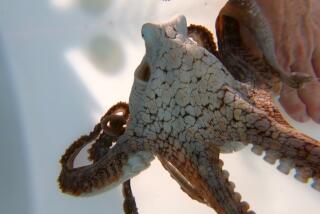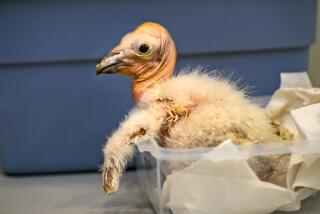Judge Calls Halt to Capturing of Condors by State
At the request of the National Audubon Society, a federal district judge in Washington on Thursday issued an injunction to bar California authorities from capturing any more wild condors and placing them in zoos.
In December, the U.S. Fish and Wildlife Service issued a permit to state authorities that authorized them to capture all six birds that remained in the wild.
One of the six, an extremely sick female known as Adult Condor 3 or AC-3, was captured on Jan. 3 and taken to the San Diego Wild Animal Park, where it is in critical condition as a result of lead poisoning.
The staff of the Condor Research Center in Ventura has had no luck in trying to capture the other birds. The five staff members involved in the hunt were called back from the field Thursday afternoon after the injunction was issued.
But a spokeswoman for the Audubon Society said: “We do not consider this a victory. We’ll be back in the courtroom (of Judge Barrington Parker) at 2 o’clock tomorrow to begin arguing our case for a permanent injunction.”
The Audubon lawsuit is asking that the U.S. Fish and Wildlife Service be barred from issuing any more permits for capture of the condors until the agency has filed an environmental impact statement about the potential effects of such a capture and until the agency has made a commitment to purchase the Hudson Ranch.
The Hudson Ranch, located near Ventura in Kern County, is an important part of the birds’ habitat, which conservationists want the federal government to purchase and maintain in a wild state.
The society also wants the Fish and Wildlife Service to order the Los Angeles and San Diego zoos not to tame any further birds that might be captured.
The California condor is one of the world’s largest birds, with a wingspan that can reach 10 feet. Last fall, there were 21 of the birds in captivity and only six in the wild. The Fish and Wildlife Service had planned to capture three of the wild six this winter and to release three zoo-raised birds in the spring.
In mid-December, however, the agency suddenly ordered all six wild birds captured. The change of heart, agency spokesman David Klinger said, was made “very reluctantly” and was based on three new factors.
Most important, one of the birds that had not been scheduled to be captured was found to be extremely ill, necessitating immediate care in a zoo.
Note Mating Behavior
In addition, biologists from the Ventura center had noticed potential mating behavior by two of the wild birds. Only one of those birds was scheduled for capture, and the scientists did not want to break up the pair since there are only two other potential breeding pairs that have formed.
Finally, the agency had inspected the captive birds and had found, in Klinger’s words, that “improper handling procedures” had left the three birds scheduled for release too tame to survive in the wild.
AC-3, the female that was captured, was found to have had eight lead shotgun pellets in her body and had potentially lethal lead levels in her blood. San Diego Wild Animal Park veterinarians treated her with drugs to remove the lead from the blood, but one of the pellets was lodged in her intestine, blocking elimination.
The bird, said William Toone of the park, has been vomiting ever since it was captured and was literally “rotting from the inside out.” By Thursday morning, AC-3’s condition had deteriorated so badly that Toone anesthetized her and cleaned out the intestines.
‘Appears More Alert’
Later in the afternoon, Toone reported that the anesthetic had worn off and that AC-3 “appears more alert.” Nonetheless, he predicted that “optimistically, she has only a 50% chance of surviving.”
More to Read
Sign up for Essential California
The most important California stories and recommendations in your inbox every morning.
You may occasionally receive promotional content from the Los Angeles Times.









